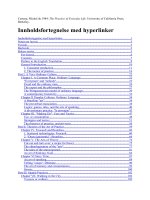university of california press millennial monsters japanese toys and the global imagination jun 2006
Bạn đang xem bản rút gọn của tài liệu. Xem và tải ngay bản đầy đủ của tài liệu tại đây (2.23 MB, 355 trang )
A
BOOK
The Philip E. Lilienthal imprint
honors special books
in commemoration of a man whose work
at University of California Press from 1954 to 1979
was marked by dedication to young authors
and to high standards in the field of Asian Studies.
Friends, family, authors, and foundations have together
endowed the Lilienthal Fund, which enables UC Press
to publish under this imprint selected books
in a way that reflects the taste and judgment
of a great and beloved editor.
The costs of publishing this book have been defrayed in part by the
Hiromi Arisawa Memorial Awards from the Books on Japan Fund.
The awards are financed by The Japan Foundation from generous
donations contributed by Japanese individuals and companies.
MILLENNIAL MONSTERS
asia: local studies/global themes
Jeffrey N. Wasserstrom, Kären Wigen, and Hue-Tam Ho Tai, Editors
1. Bicycle Citizens:The Political World of the Japanese Housewife, by Robin
M. LeBlanc
2. The Nanjing Massacre in History and Historiography, edited by Joshua
A. Fogel
3. The Country of Memory: Remaking the Past in Late Socialist Vietnam,
by Hue-Tam Ho Tai
4. Chinese Femininities/Chinese Masculinities: A Reader, edited by Susan
Brownell and Jeffrey N. Wasserstrom
5. Chinese Visions of Family and State, 1915–1953, by Susan L. Glosser
6. An Artistic Exile: A Life of Feng Zikai (1898–1975), by Geremie R. Barmé
7. Mapping Early Modern Japan: Space, Place, and Culture in the Tokugawa
Period, 1603–1868, by Marcia Yonemoto
8. Republican Beijing: The City and Its Histories, by Madeleine Yue Dong
9. Hygienic Modernity: Meanings of Health and Disease in Treaty-Port
China, by Ruth Rogaski
10. Marrow of the Nation: A History of Sport and Physical Culture in
Republican China, by Andrew D. Morris
11. Vicarious Language: Gender and Linguistic Modernity in Japan, by
Miyako Inoue
12. Japan in Print: Information and Nation in the Early Modern Period, by
Mary Elizabeth Berry
13. Millennial Monsters: Japanese Toys and the Global Imagination, by
Anne Allison
14. After the Massacre: Commemoration and Consolation in Ha My and
My Lai, by Heonik Kwon
Millennial Monsters
Japanese Toys and the Global Imagination
ANNE ALLISON
Foreword by GARY CROSS
UNIVERSITY OF CALIFORNIA PRESS
Berkeley Los Angeles London
University of California Press, one of the most distinguished university
presses in the United States, enriches lives around the world by advancing
scholarship in the humanities, social sciences, and natural sciences. Its
activities are supported by the UC Press Foundation and by philanthropic
contributions from individuals and institutions. For more information,
visit www.ucpress.edu.
University of California Press
Berkeley and Los Angeles, California
University of California Press, Ltd.
London, England
© 2006 by The Regents of the University of California
Library of Congress Cataloging-in-Publication Data
Allison, Anne, 1950–
Millennial monsters : Japanese toys and the global imagination / Anne
Allison ; foreword by Gary Cross.
p. cm.—(Asia—local studies/global themes ; 13)
Includes bibliographical references and index.
isbn 0-520-22148-6 (cloth : alk. paper)—isbn 0-520-24565-2 (pbk. : alk.
paper)
1. Toys—Japan. 2. Games—Japan. 3. Animated films—Japan.
4. Video games—Japan. 5. Consumer goods—Japan. 6. Toy industry—
Japan. 7. Toys—Japan—Marketing. 8. Philosophy, Japanese. 9. Japan—
Social life and customs. I. Title. II. Series.
gn635.j2a55 2006
688.7’20952—dc22 2005025770
Manufactured in the United States of America
15141312111009080706
10987654321
The paper used in this publication meets the minimum requirements of
ansi/niso z39.48-1992 (r 1997) (Permanence of Paper).
To Charlie
Foreword xv
Acknowledgments xix
1. Enchanted Commodities 1
2. From Ashes to Cyborgs: The Era of Reconstruction (1945–1960) 35
3. Millennial Japan: Intimate Alienation and New Age Intimacies 66
4. Mighty Morphin Power Rangers: The First Crossover Superheroes 93
5. Fierce Flesh: Sexy Schoolgirls in the Action Fantasy of Sailor Moon 128
6. Tamagotchi: The Prosthetics of Presence 163
7. Pokémon: Getting Monsters and Communicating Capitalism 192
8. “Gotta Catch ’Em All”: The Pokémonization of America
(and the World) 234
Epilogue 271
Notes 281
References 301
Index 313
Contents
2. Plane as jumbo toy: advertisement for Pokémon jet 5
3. Refusing gold: the anticonsumption stance of Sen, in Sen to
Chihiro no Kamikakushi (Spirited Away) 9
4. Techno-animism: the spirit(s) of capitalistic Japan 18
5. Cute profits: fantasy toys and global sales 23
6. Recycling the occupation: toy jeep 39
7. Gojira: a mythological monster for the atomic age 43
8. Remade for the United States: poster for Godzilla, King of
the Monsters 50
9. Robotic futures: Tetsuwan Atomu as cute machine 55
10. Identity confusion: the robot wishes he were a boy 57
11. Cross-speciation: dog’s head as flying turbo car 64
12. Team warriors: post-Fordist model of superheroism 100
13. Cyborgian “money shot”: revealing “bodily secrets” of a
mecha-hero 107
14. Joining arms: five weapons combine into one 108
15. Fusing forces: the team with its conglomerate tool 109
16. Su
¯
pa mashin (supermachine): teaming machines and Rangers
in the “live cougar” 109
17. Toy consumption/fantasy transformation: kids become
superheroes 112
18. Ranger toys by Bandai America 121
19. “Future-primitive” aesthetic: vehicular robot as lion 124
xi
Illustrations
20. Fashion action: Sailor Moon as fashionable action hero 130
21. Girl morphers in their everyday mode: Scouts doing homework 133
22. “Money shot,” girl-style: fleshy transformation of
female superhero 134
23. Teleporting across time and space: Sailor Moon’s daughter,
Chibi-chan 136
24. Girls unite: ten Scouts join forces 141
25. Ricca-chan:“Japanese” doll with her fantasy family 144
26. Ricca remodeled: different models of Japan’s most popular
postwar doll 145
27. Sailor Moon dolls for the United States: toning down fantasy
and adding Barbie 153
28. Prosthetic presence: tamagotchi as egg 171
29. The tamagotchi grows up 173
30. “Entertainment robot AIBO”: Sony’s advanced cyberdog 189
31. Pokémon capitalism: a play world where “getting” is cute 198
32. Tajiri Satoshi: designer of Pokémon Game Boy game 200
33. New Age insect collecting: virtualized species of Poké-world 202
34. Toughness and cuteness merge in pocket monsters 205
35. Three evolutionary stages of a pocket monster 209
36. Virtual geography: “Kanto,” from Pokémon Game
Boy guidebook 210
37. Geography on the grid: “Sekichiku City” on the Game
Boy screen 211
38. Pokémon epistemology: guidebook entry for Go
¯
su 214
39. Pokémon ball: weapon for catching and technology for
containing pocket monsters 220
40. Kasumi, Satoshi, and Takeshi travel to discover more
wild pokémon 225
41. Pikachu: the (cute) genesis of a global icon 227
42. Satoshi with his Pikachu 228
43. Eco-blues: restoring friendship among battling beetles 230
44. Entering American culture: Pikachu as Halloween costume 252
45. Changing play logics: evolution from Poliwog to Poliwhirl to
Poliwrath 262
xii / ILLUSTRATIONS
46. Interactivity:American kids playing competitive Pokémon
card tournaments 263
47. Product lines generated by Pokémon’s U.S. campaign 269
48. A Godzilla Americans find cool: Matsui Hideki,
nicknamed Gojira 273
ILLUSTRATIONS / xiii
ropean popular and commercial culture are continually encountering the
“monsters” of Japan—those often cute and cool critters that, especially of
late, seem to have crashed onto the scene. They make us wonder: Where did
they come from? Why have they so captured the imagination of children
and adults on a global scale? I have often thought a really informed book
about why and how Japanese popular culture has succeeded in becoming
(with American pop culture) the leading exporter of fantasy, especially to
the young, would go far in explaining both cultural globalization and con-
temporary children’s commercial culture. In these covers, we have that
book.
Of course, much of Japanese fantasy in anime, comic books, video games,
and toys has been influenced by the West. For the first sixty years of the
twentieth century, the Japanese playthings industry was indebted to Ger-
man and especially American innovation. Linkages between Japanese and
American children’s consumption were well established by the 1930s, when
Louis Marx, the famous American manufacturer of windup Popeyes and
racist “Alabama Coon Jiggers,” outsourced production to Japan.After World
War II, Japan became an exporter of robots and space toys made of tin cans
to an American market eager for science-fiction and space themes: Japanese
spaceships looked like hastily recycled tanks and other war toys, and the toy
figures looked alien to Westerners because Japanese toy makers could not
afford to license images of movie and TV icons like Flash Gordon and Space
Cadet.
By the late 1960s, however, Japan was producing quality Datsuns and
other cars for export, and it exploited the development of transistor and dig-
ital technology to drive American and European manufacturers of TVs, ra-
xv
Foreword
GARY CROSS
dios, and stereos out of business. Still, few in the West seemed to take Japa-
nese popular culture seriously. Until recently, the memory of cheesy
Godzilla movies shown for laughs on late-night television seemed to epito-
mize Japanese popular culture.The revolutionary Walkman was widely em-
braced, but not Japanese music. Japan got its own Disneyland in 1983, a
decade before Europe, but, while it had its own character,Tokyo Disneyland
was still derivative.Yet all this began to change noticeably in the 1990s with
the coming of Mighty Morphin Power Rangers, Sailor Moon, tamagotchi,
and Pokémon, along with anime movies, video games, and much else.
One factor behind this transformation was the fact that the business
models of Japanese manufacturers of playthings were consistent with
American models of merchandising and manufacturing fantasy; they did
not stick with the more parent-friendly approach of European toymakers.
As early as the 1920s, toy and children’s-book producers had learned the art
of sliding characters and stories across “platforms” of fantasy.While British
and German doll and toy makers stuck to miniaturizing adult life (e.g.,
through dolls’ houses and vehicles) and usually maintained a didactic tone,
Japanese manufacturers were influenced by American innovation in chil-
dren’s fantasy by cross-marketing characters from comic books and illus-
trated stories in the form of dolls, toys, and games. Tying toys and dolls to
children’s fantasy narratives was key to Disney’s success in the 1930s, when
Mickey Mouse became a global “friend” via sand pails, toothbrushes, and
comic books as well as through Saturday-morning gatherings of “Mickey
Mouse Clubs,” which met to watch his cartoons in neighborhood cinemas.
The merchandising of Pokémon sixty years later followed the same path.
The proliferation of Hasbro’s GI Joe “dolls” and military gear in the 1960s
and the endless action-figure montages of the 1980s—perhaps best seen in
the dizzying array of character goods spun off from the three Star Wars
movies of 1978 to 1983—were adopted by the Japanese. Despite the pres-
sures of education, work, and family, Japanese commercial culture, like the
American one, invited children into a fantasy world of playful stories and
toys divorced from adults’ memories and expectations that children should
“train” for adulthood in play. Even the Japanese cultivation of images of the
“cute” in Hello Kitty and Pikachu has been influenced by German and
American dolls and comic-strip characters from a century ago. Japanese
“millennial monsters” are part of a wider and older world of children’s fan-
tasy.
But none of this takes away from the striking impact of Japanese imagi-
nation on today’s children’s culture. Nor should it obscure the fact that
Japan’s millennial monsters represent something new. As Anne Allison
xvi / FOREWORD
shows us, what is new and important for understanding our own times is
the way that Japanese stories are told and how their characters behave and
interact. From a superficial perspective, in fact, the Power Rangers are just
another group of superhero fighters, appearing at the end of an era of
action-figure warriors that began in the late 1970s. But this would miss the
point. Japanese children’s fantasy is different and seems to be defining chil-
dren’s culture in the twenty-first century just as American dream makers
did in the twentieth.
This book tells why and how this happened by relating postwar Japanese
society to children’s fantasy culture. Even more interesting is Allison’s link-
ing of Japanese social experience to the globalization of contemporary con-
sumer culture, of which children’s longings are in the vanguard. Japanese
dream makers capture the hopes and frustrations of life in the global econ-
omy more effectively than America’s Disney. This is a big and provocative
claim often wrapped in postmodernist packaging, but it is rich, thoughtful,
and compelling.
Allison skillfully situates the well-known 1950s images of Godzilla
within the despair of recently defeated and oppressed Japan, and relates the
technological obsession of Astro Boy to the peculiarly Japanese longing for
renewal in a high-tech world. With much sensitivity, Millennial Monsters
contextualizes the seemingly contradictory world of Japanese fantasy
within both the economic boom that began in the 1960s and the subsequent
bust of the 1990s. With a deep knowledge of a culture foreign to most West-
erners, Allison shows why disciplined and overworked Japanese longed for
materialist fantasies. Technologically advanced capitalism produced a loss of
place and community, and feelings of alienation from parents and the past.
All this created longings for identity via the “friendly” characters of comic
books, toys, and cartoons,as well as merchandise emblazoned with images of
these characters. Allison shows very concretely how consumption has be-
come a replacement for social contact, and how portable entertainment—in
the form of Pokémon video games and handheld electronic pets—offers an
alternative to place and to older kinds of relationships.
Japanese children’s fantasy is riddled with technological imagery, not in
a simple celebratory fashion, as with American and European electric trains,
construction toys, and science sets of the early twentieth century, but
through machines that are infused with techno-animism, or personality and
animistic traits. Unlike the fixed world of Western children’s fantasy, Japa-
nese stories and character play are about continual transformation, or poly-
morphous perversity. Japanese cartoons, video games, and action-figure sets
are even more foreign to American adults than were the Star Wars toys of
FOREWORD / xvii
the early 1980s (which were at least modeled after older Western traditions
of heroism). Japanese stories experiment with more unexpected disruptions
of old stereotypes (as in the case of Sailor Moon, with its fashionable female
fighters and its edgy interpretation of the cute). Pokémon, or pocket mon-
sters, are simultaneously pets and fighters, exchanged but also battled with.
Yet this is more than a story of Japanese culture and childhood. The Jap-
anese experience is increasingly a global one, and its success in adapting to
the demands of the American market and convincing American children to
adapt to its aesthetics is part of the story. Western children may embrace
Japanese imagination because it is “foreign” and thus “cool,” but they also
do so because it fits the stresses and aspirations of the postmodern age and
helps them cope.
Americans, long used to hegemony in popular culture, as well as in the
political, economic, and military realms, may find this recentering of global
imagination hard to accept. Disney’s nostalgia and cultivation of the cute
and of fantasy places may continue to have global appeal, as is evidenced by
the ongoing success of Walt Disney World and its spawn in France, Japan,
and, soon, Hong Kong. But Japanese have captured the frustrations and
longings of a world now beyond nostalgia and dreams of magical places
through an ever-changing fantasy of polymorphous perversity and techno-
animism: a world of millennial monsters.
xviii / FOREWORD
This book on the fantasies of toys and the global heat of Japanese “cool”
today has been a foray into unusual (dare I say alien?) territory for an an-
thropologist. Yet my travels have hardly been solitary, and many people
have supported this project and generously assisted me along the way.
I am fortunate to have had the research for Millennial Monsters amply
funded. For financing one year of fieldwork in Japan (1999–2000), I thank
the Fulbright Program at the Japan–U.S. Educational Commission (which
also provided assistance in a myriad of other ways) as well as the Social Sci-
ence Research Council. My home institution, Duke University, was gener-
ous in not only funding shorter trips to Japan and all the United
States–based research, but also in granting me a one-semester leave to write
the book; I am grateful to the Asian Pacific Studies Institute, the College of
Arts and Sciences, and the Arts & Sciences Council at Duke University.
In Japan, people graciously took time out of busy schedules to answer my
questions about toys, character merchandise, Japanese youth, and monster
traditions. From scholars in research institutions to executives in toy and
publishing companies, and from children and their parents to toy designers
and cultural critics, many people greatly assisted my research. For their gen-
erosity in interviews, I thank Fujita Akira at Sho¯gakukan Production;
Stephen Alpert at Studio Ghibli; Ron Foster, Hori Takahiro, and Bill Ireton
at Warner Brothers; Iwata Keisuke at TV Tokyo; Kamio Shunji and Sano
Shinji at Tomy Company; Kondo¯ Sumio and Takayama Eiji at Kodomo
Cho¯sa Kenkyu¯jo; Tim Larimer at Time; Stuart Levy at Mixx Entertainment
(now TokyoPop); Steven Murawski at Grey Daiko Advertising; Sengoku Ta-
motsu at Nihon Seisho¯nen Kenkyu¯jo; Shimamoto Tatsuhi at Hakuho¯do¯
(Seikatsu So¯go¯ Kenkyu¯jo); Takashi Shintaro¯ at Media Factory, Takei Reiko
at Dentsu¯ Inc.; Bruce Weber at Mattel Japan; and Takeda Masanobu. In ad-
xix
Acknowledgments
dition, I am grateful to the countless children who assembled for group ses-
sions or individual interviews. Kubo Masakazu at Sho¯gakukan Inc., Profes-
sor Nakazawa Shin’ichi, and Okamoto Keiichi at Dentsu¯ were particularly
helpful in the interviews they gave me; I learned immeasurably from them
all. I am also indebted to Yoshimi Shunya for the good chats we had about
global youth trends, nomadic technology, and Pokémon and for the affilia-
tion he facilitated for me the year I was in Japan at the Shakai Jo¯ho¯
Kenkyu¯jo, Tokyo University. I greatly appreciate the help of fellow Ful-
brighters and other scholars during my time in Japan, including Frank Bald-
win, Jason Cremerius, Michael Foster, Jonathan Hall, Peter Kirby, Iwabuchi
Koichi, John McCreery, Tessa Morris-Suzuki, Mark Abe Noynes, Numazaki
Ichiro¯, Neil Rae, Kerry Ross, Shiraishi Saya, Hosokawa Shu¯hei, David
Slater, Ueno Chizuko, and Fujimoto Yukari. I also thank Ito¯ Rena, who was
endlessly resourceful as my Japan-based research assistant even when I re-
turned to the States. To Nick Bestor I owe my introduction to the intricate
world of Pokémon. And I appreciate the friendship of Kuse Keiko.
In the United States, I was fortunate in both the time and access that
people in the (children’s) entertainment industry accorded me. This was
particularly true in my research on Pokémon, where virtually all the main
players responsible for the marketing of the property in the United States
generously granted me interviews: Rick Arons at Wizards of the Coast;
Nancy Carson, Nancy Kirkpatrick, and Massey Rafoni at Warner Brothers;
Paul Drosos at Hasbro; Norman Grossfeld at 4Kids Entertainment; Jessica
Pinto at Kids WB; and Gail Tilden at Nintendo of America. I am particularly
thankful to Al Kahn at 4Kids Entertainment, who met with me three times
and was endlessly helpful in laying out the marketing history of Pokémon
and other Japanese imported properties in the United States.I am also grate-
ful for other interviews on Power Rangers and Sailor Moon with Barry Stag
at Bandai America, Paul Kurnit at Griffin/Bacal, and Mark McClellan and
Jean Morra at Saban Entertainment. Prior to my yearlong fieldwork in
Japan, I was given a wonderful introduction to the world of toy marketing
and advertising when I participated in the visiting professor program spon-
sored by the Advertising Educational Foundation. For my assignment to the
Hasbro crew working on Pokémon at Grey Advertising, I thank Sharon
Hudson at AEF, Mack O’Barr for arranging this, and particularly David
Biebelberg and all those at Grey who so generously gave their time to me.
As in Japan, I learned much about the toys/cartoons/games in my study
from children. I am thankful to all those who enlightened me through in-
terviews or by allowing me to play with them. In particular, I thank the kids
in my Greeley, Colorado, study, and especially Amy and Paul Rotunno for
xx / ACKNOWLEDGMENTS
setting it up; I also thank their two children, Mitch and Allison Rotunno. I
also thank my next-door neighbors Jake and Emma Bogerd for our multiple
Pokémon playdates and for all they taught me.
Throughout the long years of researching and writing Millennial Mon-
sters, I have been grateful for the support of many colleagues: Hideko Abe,
Jonathan Allum, Harumi Befu, Ted Bestor, Elizabeth Chin, Leo Ching, Ian
Condry, Dwayne Dixon, Mark Driscoll, Katherine Frank, Alessandro Go-
marasca, Andy Gordon, Larry Grossberg, Mizuko Itoh, Sharon Kinsella,
Ken Little, Ralph Litzinger, Gabriella Lukacs, William Matsui, Susan
Napier, Diane Nelson, Jennifer Prough, Kathy Rudy, Miriam Silverberg,
Steve Snyder, Laurie Spielvogel, Linda White, Kären Wigen, Ken Wissoker,
Jane Woodman, Christine Yano, and Tomiko Yoda. Since its inception, I have
been given many opportunities to speak about my research at various stages
and in various iterations. I thank all those who extended these invitations
and all the audiences who gave me such useful feedback at the Abe Fellow-
ship Program, the Annenberg School of Communication at the University
of Southern California, the College of the Atlantic, Dartmouth College, the
Humanities Center at Wesleyan College, the Japan Society, Randolph
Macon College, the Reischauer Institute at Harvard, Stanford University,
the University of British Columbia, the University of Kansas, the Univer-
sity of Oklahoma, the University of Virginia,Western Michigan University,
and Yale University. I am particularly grateful for the opportunity to partic-
ipate in a conference (held at the East West Center in 2001) devoted entirely
to the global diffusion and glocalization of Pokémon. For a wonderful col-
laboration, I thank my fellow participants and particularly Joe Tobin for
overseeing both the conference and the edited volume that emerged from it
(Pikachu’s Global Adventures). In 2004 I participated in another, differently
stimulating seminar (at the School of American Research) on youth and
globalization. For all I learned—about my own paper on Pokémon and that
of others—I am thankful to the co-organizers, Debbie Durham and Jennifer
Cole, and my coparticipants: Brad Weiss, Ann Annagnost, Barrie Thorne,
Tobia Hecht, Paula Fass, and Connie Flanagan. And to the members of my
writing group at Duke—Priscilla Wald, Maureen Quilligan, Laura Edwards,
and Adrienne Davis—I am deeply indebted for their endlessly sharp advice
and the gentleness with which they dispensed it.
For a few more, I have very special thanks. The University of California
Press has been wonderful in the production process, and I thank everyone
who has worked on Millennial Monsters. In particular, I am grateful to my
editor, Sheila Levine, for her long support and patience, and to Randy Hey-
man for his help and expertise in managing permissions. I was fortunate in
ACKNOWLEDGMENTS / xxi
the reviewers the press solicited; all were remarkably savvy and astute, and
the book benefited enormously from them. I thank all three reviewers for
their thoughtfulness: Takayuki Fujitani, Purnima Mankekar, and Bill Kelly.
To Bill I owe even deeper thanks: for his multiple reads of my manuscript,
for his unwavering support and advice, and for the invitation to Yale and
into his graduate seminar. Over the years and mainly through email,
Hyung Gu Lynn has fueled my imagination and knowledge of the Japanese
pop cultural scene.Victoria Nelson came to my assistance when the writing
was slogging to a standstill; her savviness in seeing me through was invalu-
able. I am fortunate to have the friendship of Kuga Yoshiko, who, in all my
trips to Japan, offers me bountiful resources, a generous spirit, and good
drinks. Orin Starn has been the best friend and colleague I could hope to
have. Always sharp, infinitely available, and steadfastly wise, he has my
deepest thanks. My sons, David and Adam Platzer, have been in the skin of
this project from the beginning. It was Adam’s passion for Japanese cyber-
warriors that got me going on this and David’s willingness to help me with
Game Boy technology that gave me an edge with Pokémon. For all we’ve
been through, and for all their faith and encouragement along the way, I
thank them both. I am fortunate in having a mother whose enthusiasm for
this project kept me smiling on days I was blue. Last, it is my partner, Char-
lie Piot, who has been my strongest supporter throughout. During all those
times of doubt, struggles for clarity, and attempts to write the grant (in a
“grantese” I owe, frankly, to him), he was there for me. It is Charlie who has
shown me and taught me about the “gift”—from going to Japan and end-
lessly theorizing the capitalism of monsters to forging through difficulties
together. To him, I give not thanks but the promise of a return gift.
xxii / ACKNOWLEDGMENTS
1
1 Enchanted Commodities
Peter and His Yu-Gi-Oh!
The boy is sixteen years old: a good student, a star athlete, and college-
bound. A colleague’s son, Peter is polite but bored as we chat on a warm
North Carolinian fall day in 2003. When the subject turns to hobbies, how-
ever, and I ask about Japanese fads, the sober-looking youth immediately
transforms. Practically jumping out of his seat, he announces,“I’m obsessed
with Yu-Gi-Oh!”—an obsession his father confirms while confessing total
ignorance about the phenomenon himself.A media-mix complex of trading
cards, cartoon show, comic books, video games, movie, and tie-in merchandise
that became the follow-up global youth hit on the heels of Pokémon, Yu-Gi-
Oh! entered the U.S. marketplace in 2001, promoted by the New York–based
company 4Kids Entertainment. Here, as my teenage interviewee makes clear,
lies a fantasy world where monsters, mysteries of ancient Egypt, and tough
opponents all entwine in card play—his preferred venue of Yu-Gi-Oh! play,
as well as that of his (mostly male) high school buddies.
As I learned from fieldwork over the last decade, there is a veritable boom
these days in Japanese fantasy goods among American youth.This is not the
first time, of course, that U.S. mass culture has been influenced by Japan;
Japanese cartoons like Speed Racer have played for years, for example, and
Godzilla was such a hit in the 1950s, it spawned Japanese monster sequels
for decades. But as one twenty-something young man told me recently,
J-pop (Japanese pop) is far more ubiquitous today. According to him, prop-
erties like manga (comic books) and anime (animation) are “kicking our
ass” because they are better, more imaginative, and way beyond what Hol-
lywood can muster in terms of edginess, storytelling, and complex charac-
terizations. The comparison with American pop culture is instructive. For
what is new here is not simply the presence of Japanese properties in the
2 / ENCHANTED COMMODITIES
United States or the emergence of American fans (I routinely meet diehards
who, raised on Godzilla or Speed Racer as youths, have carried the flame
into middle age). Rather, it is the far greater level of influence of Japanese
goods in the U.S. marketplace these days and upon the American national
imaginary/imagination.
As with Peter, part of the appeal of the game play is its novelty. Whether
because of the Japanese script, foreign references, or visual design, Yu-Gi-
Oh! has a feel that is distinctly non-American. Retaining, even purposely
playing up, signs of cultural difference is more the trend today than simple
Americanization of such foreign imports.
In 2003, for example, when the popular Japanese youth (comic) magazine
Sho¯nen Jump was released in the United States, it was formatted to be read
Japanese style, from right to left. Yet, why such an aesthetic is enticing
seems to do “less with a specific desire for things Japanese than for things
that simply represent some notion of global culture”—as a reporter writing
in the New York Times has said about the current manga craze in the United
States. For the “Google generation,” worldliness is both an asset and a
marker of coolness (Walker 2004:24). But whether the attraction is coded as
global culture or as culturally Japanese, it involves not only a perceived dif-
ference from American pop but also a constructed world premised on the
very notion of difference itself—of endless bodies, vistas, and powers that
perpetually break down into constituent components that reattach and re-
combine in various ways. And, as with Peter and his Yu-Gi-Oh! cards, the
pleasure of play here is studying, mastering, and manipulating these differ-
ences: an interactive activity by which something foreign soon becomes fa-
miliar.
Pokémon at LAX
It is a fall day in 1999, and a crowd of children gathers excitedly by a win-
dow at LAX airport. Gazing at the runway in front of them, they are capti-
vated by a 747 just landing from Japan that has been magically transformed
into a huge flying monster toy (figure 1). Cartoonishly drawn down the side
of the aircraft is a figure recognizable even by adults: yellow-bodied and
red-cheeked Pikachu, the signature fantasy creature from the biggest kids’
craze of the decade, Pokémon. Known for its cuteness and electric powers,
Pikachu is one of the original 151 pokémon (short for “pocket monsters”;
there are now more than 300) that inhabit an imaginary world crafted onto
a media-mix entertainment complex of electronic games, cartoons, cards,









